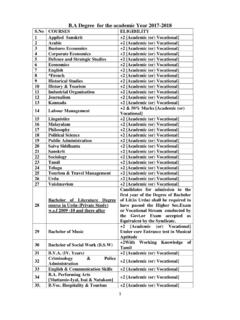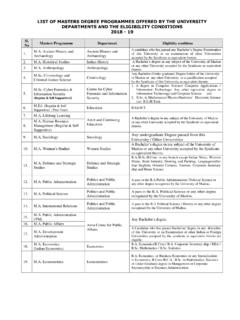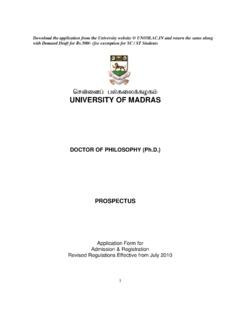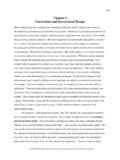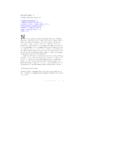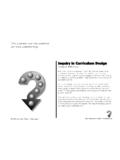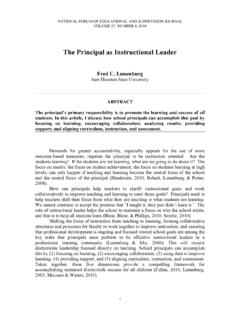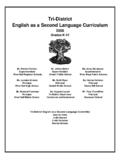Transcription of CURRICULUM DESIGN AND DEVELOPMENT-1.ppt
1 CURRICULUM DESIGN AND DEVELOPMENTDEVELOPMENTbyProf. PILLAIDEFINITIONS OF CURRICULUM That which is taught in schools A set of subjects. Content A program of studies. A program of studies. A set of materials A sequence of courses. A course of study A set of performance objectives Everything that goes on within the school, including extra-class activities, guidance, and interpersonal relationships. Everything that is planned by school personnel. A series of experiences undergone by learners A series of experiences undergone by learners in a school. That which an individual learner experiences as a result of schooling. An aggregate of courses of study in a school system. An aggregate of courses of study in a school system. Planned and unplanned concept, content, skills, work habits, means of assessment, attitudes and work habits, means of assessment, attitudes and instructional strategies taught in the classroom and the variety of school activities in and out of class that influence present and future academic, social, emotional and physical growth of students DERIVING A DEFINITION CURRICULUM IS A COMPREHENSIVEPLANFORANEDUCATIONAL/TRAINI NGPROGRAMME/COURSETOTRAININGPROGRAMME/CO URSETOOFFER NEW/IMPROVED MANPOWERTO FULFIL THE RISING NEEDS OF ADYNAMIC OF CURRICULUM (according to the four families of learning theories) Social, Information Processing, Personalist, and Behavioral.
2 TO CURRICULUM child-centered, society-centered, knowledge-centered, or eclectic. eclectic. Educational Philosophy What is knowledge and understanding? What is worth knowing? What does it mean to learn? How do you know that learning has taken place? How do you know that learning has taken place? What should be the role of a teacher? What should be the role of the student? What is the ultimate purpose of education? What are your core educational values? APPROACHES TO CURRICULUM (Common philosophical orientations) Idealism, Realism, Perennialism, Essentialism, Essentialism, Experimentalism, Existentialism, Constructivism, ReconstructivismIdealism Subjective Idealism, only ideas can be known or have any reality (also known as solipsism). Transcendental Idealism, developed by Kant, this theory argues that all knowledge originates in perceived phenomena which have been organized by categories.
3 Absolute Idealism, all objects are identical with some idea and the ideal knowledge is itself the system of ideas. It is also Objective Idealism, in this monistic idealism promoted by Hegel there is only one mind in which reality is created. Platonic Idealism, there exists a perfect realm of Form and Ideas and our world merely contains shadows of that realm. merely contains shadows of that realm. Idealism believes in refined wisdom; reality is a world within a person's mind; truth is in the consistency of ideas and goodness is an ideal state to strive to attain. As a result, schools exist to sharpen the mind and intellectual processes. Students are taught the wisdom of past Classical realism held universals such as "red" or "man" an independent, objective existence, either in a realm of their own or in the mind of God. Medieval realism, contrasted with Nominalism, provided by Peter Abelard and William of Occam.
4 Modern realism is a broad term, encompassing several movements whose unity lies in a common rejection of philosophical Idealism. Realism asserts that objects in the external world exist independently of what is thought about them. The most straightforward of such theories is usually known as naive realism. The most straightforward of such theories is usually known as naive realism. Realism believes in the world as it is. It is based on the view that reality is what we observe. It believes that truth is what we sense and observe and that goodness is found in the order of the laws of nature. As a result, schools exist to reveal the order of the world and universe. Students are taught factual (1) Permanence is more real than change. (2) Human nature remains essentially the same. (3) The good life -- the life that is fit for men to live -- remains essentially the same. (4) Moral principles remain essentially the same.
5 (5) Hence, the education that men receive should remain essentially the same. "Education implies teaching. Teaching implies knowledge. Knowledge is truth. The truth everywhere is the same. Hence, education should be everywhere the same."same." This is a very conservative and inflexible philosophy of education. It is based on the view that reality comes from fundamental fixed truths-especially related to God. It believes that people find truth through reasoning and revelation and that goodness is found in rational thinking. As a result, schools exist to teach reason and God's will. Students are taught to reason through structured lessons and drills. Socratic dialogue. , M. AdlerEssentialism Essentialism is a uniquely American philosophy of education which began in the 1930 s and 1940 s as a reaction to what was seen as an overemphasis on a child-centered approach to education and a concern that students were not gaining appropriate knowledge in The two origins of essentialism are idealism and realism.
6 Essentialists believe that there exists a critical core of information and skill that an educated person must have. Didactic Instruction. , W. Bagely, W. Experimentalism believes that things are constantly changing. It is based on the view that reality is what you experience. It believes that truth is what works right now and that goodness comes from group from group decisions. As a result, schools exist to discover and expand the society we live in. Students study social experiences and solve Existentialism believes in the personal interpretation of the world. It is based on the view that the individual defines reality, truth and goodness. As a result, schools exist to aid children in knowing themselves and their place in society. As a result, schools exist to aid children in knowing themselves and their place in society. Students learn what they want and discuss subjects freely.
7 Creative self-directed choices. Discovery learning. NeilConstructivism Learning is simply the process of adjusting our mental models to accommodate new experiences. Learning is a search for meaning. Meaning requires understanding wholesas well as parts. requires understanding wholesas well as parts. In order to teach well, we must understand the mental models that students use to perceive the world The purpose of learning is for an individual to construct his or her own meaning, not just memorize the right answers and regurgitate someone else s meaningReconstructivism Focus is on providing students the critical tools to be agents of social change. Students explore controversial issues, analyze world events. P. Freire. Progressivism: The goal is to help each student think rationally. Student-centered approach. Project and problem-based learning. John Dewey Postmodernism: Focus on helping students recognize that here are no Postmodernism: Focus on helping students recognize that here are no universal truths, and the traditional narratives of the dominant culture must be deconstructed.
8 Deconstruction through dialogue. Critical pedagogy. M. Foucault. Behaviourism: Free will is an illusion, students' behaviour is shaped in order to reinforce proper learning and behavior. Drill and practice. SkinnerTYPES OF CURRICULUM , explicit, or written CURRICULUM CURRICULUM 3. The hidden or covert CURRICULUM null CURRICULUM null CURRICULUM CURRICULUM CURRICULUM CURRICULUM CURRICULUM 10. The internal CURRICULUM electronic CURRICULUM electronic CURRICULUM CurriculumOvert, explicit, or written CURRICULUM that which is written as part of formal instruction of schooling experiences. refers to a CURRICULUM document, texts, films, and supportive teaching materials that are overtly chosen to support the intentional instructional chosen to support the intentional instructional agenda of a school. usually confined to those written understandings and directions formally designated and reviewed by administrators, CURRICULUM directors and teachers, often collectively.
9 Societal CURRICULUM Cortes defines this CURRICULUM as the massive, ongoing, informal CURRICULUM of family, peer groups, neighborhoods, churches organizations, occupations, churches organizations, occupations, mass, media and other socializing forces that "educate" all of us throughout our lives The hidden or covert CURRICULUM That which is implied by the very structure and nature of schools, much of what revolves around daily or established routines. the "hidden CURRICULUM ," which refers to the kinds of learnings children derive from the very nature and organizational DESIGN of the public school, as well as from the behaviors and attitudes of teachers and administrators - Longstreet and Shane the emphasis on: sequential room arrangements; the cellular, timed the emphasis on: sequential room arrangements; the cellular, timed segments of formal instruction; an annual schedule that is still arranged to accommodate an agrarian age; disciplined messages where concentration equates to student behaviors were they are sitting up straight and are continually quiet; students getting in and standing in line silently; students quietly raising their hands to be called on; the endless competition for grades, and so on.
10 The null CURRICULUM That which we do not teach, thus giving students the message that these elements are not important in their educational experiences or in our society -Eisnerexperiences or in our society -Eisner the null CURRICULUM is simply that which is not taught in schools. Somehow, somewhere, some people are empowered to make conscious decisions as to what is to be included and what is to be excluded from the overt (written) CURRICULUM . Since it is physically impossible to teach everything in schools, many topics and subject areas must be intentionally excluded from the written CURRICULUM . the written CURRICULUM . the "null CURRICULUM " is that when certain subjects or topics are left out of the overt CURRICULUM , school personnel are sending messages to students that certain content and processes are not important enough to study. Unfortunately, without some level of awareness that there is also a well-defined implicit agenda in schools, school personnel send this same type of message via the hidden CURRICULUM .
